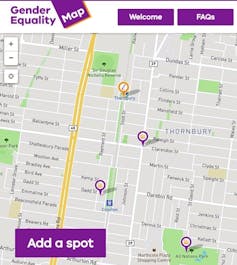Crowd-mapping gender equality – a powerful tool for shaping a better city launches in Melbourne
- Written by Nicole Kalms, Director of XYX Lab + Senior Lecturer in the Faculty of Art, Design and Architecture at Monash University, Monash University
Inequity in cities has a long history. The importance of social and community planning to meet the challenge of creating people-centred cities looms large. While planners, government and designers have long understood the problem, uncovering the many important marginalised stories is an enormous task.
Technology – so often bemoaned – has provided an unexpected and powerful primary tool for designers and makers of cities. Crowd-mapping asks the community to anonymously engage and map their experiences using their smartphones and via a web app. The focus of the new Gender Equality Map launched today in two pilot locations in Melbourne is on equality or inequality in their neighbourhood.
Read more: To design safer parks for women, city planners must listen to their stories
How does it work?
 Participants can map their experience of equality or inequality in their neighbourhood using locator pins.
Author provided
Participants can map their experience of equality or inequality in their neighbourhood using locator pins.
Author provided
Crowd-mapping generates geolocative data. This is made up of points “dropped” to a precise geographical location. The data can then be analysed and synthesised for insights, tendencies and “hotspots”.
The diversity of its applications shows the adaptability of the method. The digital, community-based method of crowd-mapping has been used across the globe. Under-represented citizens have embraced the opportunity to tell their stories as a way to engage with and change their experience of cities.
CrowdSpot and Monash University have developed the Gender Equality Map with support from the Victorian government. It will enable local government to tackle the issues of socio-cultural exclusion that have proven so elusive. The map will help uncover real experiences of gender inequality in public places, from local sports facilities to public transport, community services and infrastructure, to simply walking down the street.
Read more: Gender makes a world of difference for safety on public transport
How will the data be used?
Melton and Darebin city councils will pilot the project. These councils are committed to engaging with the data in future decision-making with direct impacts on their communities and neighbourhoods.
The map is open to all genders with residence of Darebin and Melton encouraged to use the web app to tell their story. While we expect to see stories from women and men of a range of ages, the Gender Equality Map is also an opportunity to hear about the nuanced experiences of LGBTIQ+ people.
More than a new narrative of city life, the Gender Equality Map and crowd-mapping projects more broadly reflect a shift in how we understand cities, architecture and urban planning. To understand patterns of inclusion and exclusion, to consider individual perceptions of cities – ones that may not align with our own – is one of the greatest challenges place-makers face.
Trained as an architect and landscape architect and as the director of a university research lab, my research is committed to understanding the nexus of urban place and gender inequity. My recent research focuses on the possibilities and power of crowd-mapping as a method for shaping urban space. Recognising that cities need to be gender-sensitive, I seek to understand the stories of gender, equity and identity in cities – not fictional ones but real-life stories of individual people.
Read more: Safe in the City? Girls tell it like it is
Leading to more inclusive urban design
As a democratic process, crowd-mapping can lead to action that helps solve real-world issues. To design “inclusively” is more than a matter of providing community buildings, public transport and amenity. It’s about the determination to seek out the tricky stories of social justice – those of access, equity and diversity – and to actively shape our cities with these goals as our priority.
Considering how communities can advance agendas and unlock many of the complex and diverse needs of cities requires a tactical approach. Feminist architect and activist Lori Brown states:
Design is not a passive act. It is a critical engagement with community and you have to be cognisant of the power that you have and how you use it.
Crowd-mapping engages with community but also brings with it a particularly powerful form of activism – especially when it comes to gender inequity. Projects such as Everyday Sexism in the UK; Safetipin in New Delhi, Jakarta, Bogota and Nairobi; Harassmap in India; and Free to Be in Australia and internationally, have publicly charted the ways women, in particular, experience inequity in cities.
Read more: Sexism and the city: how urban planning has failed women
One obvious advantage is that web-based crowd-sourcing can challenge the historically disproportionate contribution of usually male voices in urban policy and design. One of the reasons crowd-mapping has been successful at engaging with women and girls is that it allows them to report when and where it suits them. What more will we learn about inclusion when we open up the tool to all genders?
The ubiquity of smartphone technology over the past decade has driven exponential growth in the volume of data about cities and their citizens. We have less data, however, about gender and inequity. More data and deeper insights will make these issues central to the design and strategy of local, urban decision-making.
Read more: Mansplaining Australian cities – we can do something about that
Authors: Nicole Kalms, Director of XYX Lab + Senior Lecturer in the Faculty of Art, Design and Architecture at Monash University, Monash University



